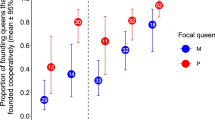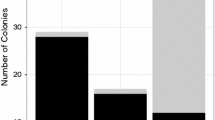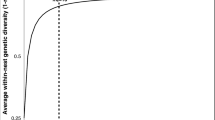Abstract
Colony social organization in the fire ant Solenopsis invicta appears to be under strong genetic control. In the invasive USA range, polygyny (multiple queens per colony) is marked by the presence of the Gp-9 b allele in most of a colony’s workers, whereas monogyny (single queen per colony) is associated with the exclusive occurrence of the Gp-9 B allele. Ross and Keller, Behav Ecol Sociobiol 51:287–295 (2002) experimentally manipulated social organization by cross-fostering queens into colonies of the alternate form, thereby changing adult worker Gp-9 genotype frequencies over time. Although these authors showed that social behavior switched predictably when the frequency of b-bearing adult workers crossed a threshold of 5–10%, the possibility that queen effects caused the conversions could not be excluded entirely. We addressed this problem by fostering polygyne brood into queenright monogyne colonies. All such treatment colonies switched social organization to become polygyne, coincident with their proportions of b-bearing workers exceeding 12%. Our results support the conclusion that polygyny in S. invicta is induced by a minimum frequency of colony workers carrying the b allele, and further confirm that its expression is independent of queen genotype or history, worker genotypes at genes not linked to Gp-9, and colony genetic diversity.


Similar content being viewed by others
References
Aron S, Vargo EL, Passera L (1995) Primary and secondary sex ratios in monogyne colonies of the fire ant. Anim Behav 49:749–757
Cahan S, Helms KR, Rissing SW (1998) An abrupt transition in colony founding behaviour in the ant Messor pergandei. Anim Behav 55:1583–1594
Calabi P, Porter SD (1989) Worker longevity in the fire ant Solenopsis invicta: ergonomic considerations of correlations between temperature, size and metabolic rates. J Insect Physiol 35:643–649
DeHeer CJ, Goodisman MAD, Ross KG (1999) Queen dispersal strategies in the multiple-queen form of the fire ant Solenopsis invicta. Am Nat 153:660–675
Endler A, Liebig J, Hölldobler B (2006) Queen fertility, egg marking and colony size in the ant Camponotus fIoridanus. Behav Ecol Sociobiol 59:490–499
Fletcher DJC (1986) Triple action of queen pheromones in the regulation of reproduction in fire ant (Solenopsis invicta) colonies. In: Porchet M, Andries J-C, Dhainaut A (eds) Advances in invertebrate reproduction 4. Elsevier, London, pp 305–316
Fletcher DJC, Blum MS (1983) Regulation of queen number by workers in colonies of social insects. Science 219:312–314
Fritz GN, Vander Meer RK, Preston CA (2006) Selective male mortality in the red imported fire ant, Solenopsis invicta. Genetics 173:207–213
Gardner A, West SA, Barton NH (2007) The relation between multilocus population genetics and social evolution theory. Am Nat 169:207–226
Goodisman MAD, Mack PD, Pearse DE, Ross KG (1999) Effects of a single gene on worker and male body mass in the fire ant Solenopsis invicta (Hymenoptera: Formicidae). Ann Entomol Soc Am 92:563–570
Goodisman MAD, Sankovich KA, Kovacs JL (2007) Genetic and morphological variation over space and time in the invasive fire ant Solenopsis invicta. Biological Invasions 9:571–584
Gotzek D, Ross KG (2007) Genetic regulation of colony social organization in fire ants: an integrative overview. Q Rev Biol 82:201–226
Helms Cahan S, Keller L (2003) Complex hybrid origin of genetic caste determination in harvester ants. Nature 424:306–309
Helms Cahan S, Julian GE, Rissing SW, Schwander T, Parker JD, Keller L (2004) Loss of phenotypic plasticity generates genotype-caste association in harvester ants. Curr Biol 14:2277–2282
Hölldobler B, Wilson EO (1977) The number of queens: an important trait in ant evolution. Naturwissenschaften 64:8–15
Hunt GJ, Page RE, Fondrk MK, Dullum CJ (1995) Major quantitative trait loci affecting honey bee foraging behavior. Genetics 141:1537–1545
Hunt GJ, Guzmán-Novoa E, Fondrk MK, Page RE (1998) Quantitative trait loci for honey bee stinging behavior and body size. Genetics 148:1203–1213
Johnson RN, Oldroyd BP, Barron AB, Crozier RH (2002) Genetic control of the honey bee (Apis mellifera) dance language: segregating dance forms in a backcrossed colony. J Heredity 93:170–173
Jouvenaz DP, Allen GE, Banks WA, Wojcik DP (1977) A survey for pathogens of fire ants, Solenopsis spp. in the southeastern United States. Fla Entomol 60:275–279
Julian GE, Fewell JH, Gadau J, Johnson RA, Larrabee D (2002) Genetic determination of the queen caste in an ant hybrid zone. Proc Natl Acad Sci U S A 99:8157–8160
Keller L, Ross KG (1993) Phenotypic basis of reproductive success in a social insect: genetic and social determinants. Science 260:1107–1110
Keller L, Ross KG (1998) Selfish genes: a green beard in the red fire ant. Nature 394:573–575
Keller L, Ross KG (1999) Major gene effects on phenotype and fitness: the relative roles of Pgm-3 and Gp-9 in introduced populations of the fire ant Solenopsis invicta. J Evol Biol 21:672–680
Krieger MJB, Keller L (1997) Polymorphism at dinucleotide microsatellite loci in fire ant Solenopsis invicta populations. Mol Ecol 6:997–999
Krieger MJB, Ross KG (2002) Identification of a major gene regulating complex social behavior. Science 295:328–332
Linksvayer TA, Wade MJ (2005) The evolutionary origin and elaboration of sociality in the aculeate Hymenoptera: maternal effects, sib-social effects, and heterochrony. Q Rev Biol 8:317–336
Maynard Smith J, Szathmáry E (1995) The major transitions in evolution. Freeman, New York
Mescher MC, Ross KG, Shoemaker DD, Keller L, Krieger MJB (2003) Distribution of the two social forms of the fire ant Solenopsis invicta (Hymenoptera: Formicidae) in the native South American range. Ann Entomol Soc Am 96:810–817
Morel L, Vander Meer RK, Lofgren CS (1990) Comparison of nestmate recognition between monogyne and polygyne populations of Solenopsis invicta (Hymenoptera: Formicidae). Ann Entomol Soc Am 83:642–647
Moritz RFA (1988) A reevaluation of the two-locus model for hygienic behavior in honeybees (Apis mellifera L.). J Heredity 79:257–262
Obin MS, Morel L, Vander Meer RK (1993) Unexpected, well-developed nestmate recognition in laboratory colonies of polygyne imported fire ants (Hymenoptera: Formicidae). J Insect Behav 6:579–589
O’Neal J, Markin GP (1975) Brood development of the various castes of the imported fire ant, Solenopsis invicta Buren (Hymenoptera: Formicidae). J Kans Entomol Soc 48:152–159
Passera L, Aron S, Vargo EL, Keller L (2001) Queen control of sex ratio in fire ants. Science 293:1308–1310
Plateaux-Quénu C, Plateaux L, Packer L (2000) Population-typical behaviours are retained when eusocial and non-eusocial forms of Evylaeus albipes (F.) (Hymenoptera, Halictidae) are reared simultaneously in the laboratory. Insectes Soc 47:263–270
Porter SD, Tschinkel WR (1985) Fire ant polymorphism (Hymenoptera: Formicidae): factors affecting worker size. Ann Entomol Soc Am 78:381–386
Queller DC, Goodnight KF (1989) Estimating relatedness using genetic markers. Evolution 43:258–275
Robinson GE (1999) Integrative animal behaviour and sociogenomics. Trends Ecol Evol 14:202–205
Robinson GE, Grozinger CM, Whitfield CW (2005) Sociogenomics: social life in molecular terms. Nat Rev Gen 6:257–270
Ross KG (1988) Differential reproduction in multiple-queen colonies of the fire ant Solenopsis invicta (Hymenoptera: Formicidae). Behav Ecol Sociobiol 23:341–355
Ross KG (1993) The breeding system of the fire ant Solenopsis invicta: effects on colony genetic structure. Am Nat 141:554–576
Ross KG (1997) Multilocus evolution in fire ants: effects of selection, gene flow, and recombination. Genetics 145:961–974
Ross KG, Fletcher DJC (1985) Comparative study of genetic and social structure in two forms of the fire ant, Solenopsis invicta (Hymenoptera: Formicidae). Behav Ecol Sociobiol 17:349–356
Ross KG, Keller L (1998) Genetic control of social organization in an ant. Proc Natl Acad Sci U S A 95:14232–14237
Ross KG, Keller L (2002) Experimental conversion of colony social organization by manipulation of worker genotype composition in fire ants (Solenopsis invicta). Behav Ecol Sociobiol 51:287–295
Ross KG, Vargo EL, Fletcher DJC (1987) Comparative biochemical genetics of three fire ant species in North America, with special reference to the two social forms of Solenopsis invicta (Hymenoptera: Formicidae). Evolution 41:979–990
Ross KG, Vargo EL, Keller L (1996) Social evolution in a new environment: the case of introduced fire ants. Proc Natl Acad Sci U S A 93:3021–3025
Ross KG, Krieger MJB, Shoemaker DD, Vargo EL, Keller L (1997) Hierarchical analysis of genetic structure in native fire ant populations: results from three classes of molecular markers. Genetics 147:643–655
Ross KG, Shoemaker DD, Krieger MJB, DeHeer CJ, Keller L (1999) Assessing genetic structure with multiple classes of molecular markers: a case study involving the introduced fire ant Solenopsis invicta. Mol Biol Evol 16:525–543
Ross KG, Krieger MJB, Keller L, Shoemaker DD (2007) Genetic variation and structure in native populations of the fire ant Solenopsis invicta: evolutionary and demographic implications. Biol J Linn Soc 92:541–560
Shoemaker DD, DeHeer CJ, Krieger MJB, Ross KG (2006) Population genetics of the invasive fire ant Solenopsis invicta (Hymenoptera: Formicidae) in the United States. Ann Entomol Soc Am 99:1213–1233
Stamps WT, Vinson SB (1991) Raiding in newly founded colonies of Solenopsis invicta Buren (Hymenoptera: Formicidae). Environ Entomol 20:137–141
Trump RF, Thompson VC, Rothenbuhler WC (1967) Behaviour genetics of nest cleaning in honeybees. V. Effect of previous experience and composition of mixed colonies on response to disease-killed brood. J Apic Res 6:127–131
Tschinkel WR (1992) Brood raiding in the fire ant Solenopsis invicta (Hymenoptera: Formicidae): laboratory and field observations. Ann Entomol Soc Am 85:638–646
Turelli M, Hoffmann AA (1995) Cytoplasmic incompatibility in Drosophila simulans: dynamics and parameter estimates from natural populations. Genetics 140:1319–1338
Vander Meer RK, Alonso LE (2002) Queen primer pheromone affects conspecific fire ant (Solenopsis invicta) aggression. Behav Ecol Sociobiol 51:122–130
Vogt RG (2005) Molecular basis of pheromone detection in insects. In: Gilbert LI, Iatro K, Gill S (eds) Comprehensive insect physiology, biochemistry, pharmacology and molecular biology. Endocrinology vol. 3. Elsevier, London, pp 753–804
Weir BS (1996) Genetic data analysis II. Sinauer, Sunderland, Massachusetts
Acknowledgements
We thank Chris DeHeer, Laurent Keller, Emily Matthews, and Yannick Wurm for comments on the manuscript.
Author information
Authors and Affiliations
Corresponding author
Rights and permissions
About this article
Cite this article
Gotzek, D., Ross, K.G. Experimental Conversion of Colony Social Organization in Fire Ants (Solenopsis invicta): Worker Genotype Manipulation in the Absence of Queen Effects. J Insect Behav 21, 337–350 (2008). https://doi.org/10.1007/s10905-008-9130-7
Revised:
Accepted:
Published:
Issue Date:
DOI: https://doi.org/10.1007/s10905-008-9130-7




